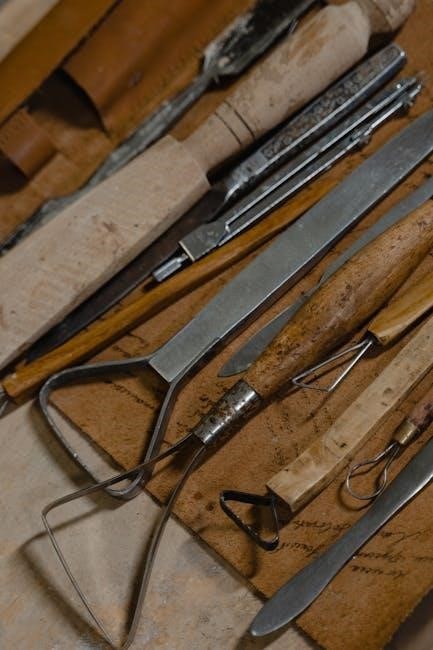The Cub Cadet LTX 1045 is a hydrostatic lawn tractor designed for efficient mowing and yard maintenance. With a 42-inch cutting deck and user-friendly controls, it offers reliability and ease of use. This guide provides essential information for safe operation, setup, and maintenance, ensuring optimal performance and longevity of your tractor.
1.1 Overview of the Cub Cadet LTX 1045 Lawn Tractor
The Cub Cadet LTX 1045 is a versatile and powerful lawn tractor designed for efficient mowing and yard maintenance. Equipped with a 42-inch cutting deck, it delivers precise cutting performance. The hydrostatic transmission ensures smooth speed control, while the ergonomic design provides comfort during extended use. Safety features, such as the seat belt and roll bar, enhance operator protection. The tractor is suitable for various terrain types and offers easy-to-use controls. Regular maintenance, as outlined in the manual, ensures optimal performance and longevity. Whether for small or large yards, the LTX 1045 is a reliable choice for homeowners seeking durability and ease of operation.
1.2 Importance of the Operator’s Manual
The operator’s manual is an essential guide for safely and effectively operating the Cub Cadet LTX 1045 lawn tractor. It provides detailed instructions on setup, operation, and maintenance, ensuring optimal performance and longevity. The manual includes critical safety information, such as warnings and precautions, to prevent accidents and injuries. By following the manual, users can avoid costly repairs and maintain warranty coverage. It also offers troubleshooting tips and maintenance schedules to keep the tractor in top condition. Reading and understanding the manual is crucial for mastering the tractor’s features and ensuring safe, efficient mowing. Failure to comply with its instructions may result in personal injury or equipment damage.

Safety Precautions and Warnings

Heed all warnings to prevent injury. Avoid slopes over 15 degrees, never modify the engine, and follow California Proposition 65 guidelines for handling lead-containing parts. Wash hands after handling.

2.1 Safety Symbols and Their Meanings
The Cub Cadet LTX 1045 manual uses specific safety symbols to alert operators of potential hazards. These symbols are crucial for safe operation and must be understood before use. Common symbols include a warning triangle with an exclamation mark, indicating general warnings, and a circle with a line through it, signifying prohibited actions. Other symbols may represent specific hazards like fire or electrical risks. Each symbol is accompanied by explanatory text to ensure clarity. Operators should carefully review these symbols in the manual to avoid accidents. Understanding these warnings is essential for protecting yourself and others while operating the tractor. Always refer to the manual for detailed explanations of each symbol.
2.2 General Safety Rules for Operating the Tractor
Always wear protective gear, including safety glasses and sturdy footwear, when operating the Cub Cadet LTX 1045. Ensure the area is clear of obstacles, children, and pets before mowing. Never allow untrained individuals, especially children, to operate the tractor. Use the rollover protective structure (ROPS) and ensure the seat belt is securely fastened if equipped. Avoid operating the tractor on slopes exceeding 15 degrees, as indicated by the slope gauge. Never modify the tractor or tamper with safety features, as this can lead to serious injury. Keep hands and feet away from moving parts, and never leave the tractor unattended while it is running. Adhere to all safety guidelines to ensure safe and effective operation.
2.3 Slope Operation Guidelines
Operating the Cub Cadet LTX 1045 on slopes requires extreme caution to prevent tip-over accidents. Use the slope gauge provided in the manual to measure inclines before mowing. Never mow on slopes exceeding 15 degrees, as indicated by the gauge. Always mow up and down slopes, never across them, to maintain stability. If you feel uneasy on a slope, avoid mowing it. Keep the tractor at a slow, controlled speed and avoid sudden turns or stops. Loss of control on slopes can result in serious injury or death. Adhere to these guidelines to ensure safe operation on uneven terrain.
2.4 California Proposition 65 Warning
The Cub Cadet LTX 1045 includes components that contain chemicals known to the State of California to cause cancer and reproductive harm. Battery posts, terminals, and related accessories contain lead and lead compounds, which are harmful. Wash hands thoroughly after handling these parts. Engine exhaust and certain vehicle components emit chemicals linked to cancer and birth defects. This warning is provided in compliance with California Proposition 65. Users are advised to handle these components responsibly and follow all safety precautions outlined in the manual to minimize exposure risks. For more details, refer to the full Proposition 65 disclosure in the manual.
Setting Up the Tractor
Proper setup ensures safe and efficient operation. Follow assembly instructions, connect the battery, check tire pressure, adjust the seat, and fuel the tractor before first use.
3.1 Assembly and Initial Setup
Begin by carefully unpacking and inspecting the tractor for any shipping damage. Remove all packaging materials and the shipping brace from the mower deck. Before starting, ensure the tractor is on a level surface and the parking brake is engaged. Check the engine oil level using the dipstick and add oil if necessary. Inflate the tires to the recommended pressure, as specified in the manual. Adjust the seat to a comfortable position and ensure it locks securely. Familiarize yourself with the controls and safety features. Finally, perform a thorough safety check, ensuring all guards and shields are in place. Refer to the manual for detailed assembly instructions to ensure proper setup and safe operation.

3.2 Battery Connection and Maintenance
Connect the battery cables by attaching the positive (red) wire to the positive terminal and the negative (black) wire to the negative terminal. Ensure terminals are clean and secure. If the battery is not in service, charge it as instructed in the manual before use. Regularly inspect terminals for corrosion and tighten connections if necessary. Keep the battery area clean to prevent damage. Always wear protective gloves and eyewear when handling batteries. Avoid overcharging, as it can reduce battery life. Store the battery in a cool, dry place during off-seasons. Refer to the manual for specific charging instructions and maintenance tips to ensure optimal performance and longevity of your tractor’s battery.
3.3 Tire Pressure Adjustment
Check tire pressure before each use, as proper inflation ensures optimal performance and safety. Refer to the manual for recommended pressure specifications. Tires may be overinflated for shipping, so reduce pressure to the recommended level before operating. Use a tire pressure gauge to ensure accuracy. Overinflation can lead to reduced traction, while underinflation may cause uneven wear. Adjust pressure on a firm, level surface when tires are cold. Never deflate tires to achieve lower pressure without consulting the manual. Proper tire pressure maintains stability, especially on slopes, and prevents potential damage to the tractor. Always follow the manufacturer’s guidelines for tire maintenance and adjustment.
3.4 Seat Adjustment and Safety Features
Adjust the seat to a comfortable position by pulling the seat adjustment lever and sliding the seat forward or backward. Ensure the seat is securely locked into place before operating the tractor. The parking brake must be engaged and the seat must click into the seat-stop to ensure safety. Always check that the seat is properly engaged to prevent movement during operation. These features are designed to enhance operator safety and stability, especially on uneven terrain. Proper seat adjustment and engagement are critical for maintaining control of the tractor and preventing accidents. Follow the manual’s instructions for correct adjustment and safety protocols.

3.5 Fueling the Tractor
The Cub Cadet LTX 1045 has a 3.5-gallon fuel tank located under the hood. Use clean, fresh, unleaded gasoline (no more than 30 days old) for optimal performance. To refuel, remove the fuel cap by turning it counterclockwise. For California models with a tethered cap, stop filling once fuel is visible in the filler neck to avoid overfilling. Never fuel the tractor indoors, near open flames, or while the engine is hot or running. Always extinguish cigarettes and other ignition sources before refueling. After fueling, securely tighten the cap. Check the oil level before each use, as instructed in the manual, to ensure proper engine function and longevity.

Operating the Tractor
Operate the Cub Cadet LTX 1045 with ease using its intuitive controls. Start the engine with the ignition key, ensure the brake pedal is fully depressed, and engage the PTO for mowing. Adjust the throttle for desired speed and use the deck lift lever to set cutting height. Always disengage the PTO, set the parking brake, and stop the engine before leaving the tractor unattended. Follow safety guidelines for efficient and safe operation.
4.1 Controls and Features Overview
The Cub Cadet LTX 1045 features intuitive controls designed for ease of operation. The throttle/choke lever, located on the left dash, controls engine speed and aids in cold starting. The brake pedal on the left side enables quick stops and parking brake engagement. The deck lift lever on the right fender adjusts the cutting height, while the seat adjustment lever under the seat ensures a comfortable fit. Additional features include a hydrostatic transmission for smooth speed control and a PTO switch for engaging the mowing deck. These controls work together to provide a seamless mowing experience, ensuring precision and safety during operation.

4.2 Starting and Stopping the Engine
To start the engine, insert the key into the ignition switch and turn it clockwise to the START position. Release the key once the engine fires, allowing it to return to the NORMAL MOWING MODE position. Ensure the throttle/choke lever is in the correct position for starting—fully forward for cold starts. Always press the brake pedal fully to activate the safety interlock before starting. To stop the engine, turn the ignition key counterclockwise to the OFF position. Ensure the PTO is disengaged, the parking brake is set, and the key is removed to prevent unintended starting. Follow these steps carefully to ensure safe operation.
4.3 Mowing Tips and Best Practices
For optimal mowing performance with the Cub Cadet LTX 1045, maintain the throttle/choke lever in the FAST position when the cutting deck is engaged. Mow in a consistent pattern, turning at the end of each pass to avoid missing spots. Avoid mowing in reverse unless necessary, and always look behind you when doing so. Keep the mowing deck clear of debris and ensure it is properly adjusted for even cutting. Regularly sharpen the blade to maintain a clean cut and promote healthy grass growth. Use the mulching feature for smaller clippings or bagging for a cleaner finish. Always mow on level ground and avoid steep slopes to ensure safety and even results.
4.4 Transporting the Tractor Safely
When transporting the Cub Cadet LTX 1045, always disengage the PTO and lower the mowing deck to its lowest position. Use a sturdy trailer or truck bed, ensuring the tractor is securely tied down with straps or chains. Engage the parking brake and remove the ignition key to prevent accidental movement. Never leave the tractor unattended during transport. Ensure the trailer is properly hitched to the towing vehicle, and all lights are functional for visibility. Avoid sudden acceleration or braking to maintain stability. Always follow local towing regulations and ensure the tractor is loaded and unloaded on a firm, level surface to prevent tipping.
4.5 Using Attachments and Accessories
Using attachments and accessories on the Cub Cadet LTX 1045 enhances its versatility for various yard tasks. Always follow the manufacturer’s instructions for installation and operation. Ensure all attachments are compatible with your tractor’s model and specifications. Before use, inspect attachments for damage or wear. Engage the PTO (Power Take-Off) only when the attachment is properly secured and aligned. For grass catchers, baggers, or snow throwers, refer to the manual for specific setup guidelines. Never modify attachments or use them in ways not recommended. Properly secure loose clothing or long hair to avoid entanglement. Always maintain a safe distance from bystanders when operating with attachments.
Maintenance and Care
Regular maintenance ensures optimal performance and longevity of the Cub Cadet LTX 1045. Perform routine checks, oil changes, and lubrication. Inspect and maintain the deck, battery, and belts. Follow manual guidelines for proper care.
5.1 Routine Maintenance Checks
Regular maintenance is crucial for the Cub Cadet LTX 1045’s performance and longevity. Always start by checking the engine oil level before each use, ensuring it meets the recommended grade and level specified in the manual. Inspect the tire pressure and adjust according to the sidewall specifications to maintain proper traction and stability. Examine the mowing deck for sharpness, damage, or wear, and clean it regularly to prevent rust and debris buildup. Check the battery terminals for corrosion and secure connections, ensuring proper charging and starting capabilities. Additionally, inspect the belts for signs of wear or cracks and replace them if necessary. Lubricate all moving parts as outlined in the manual to maintain smooth operation. Regularly sharpen the blades and ensure all safety features are functioning correctly. By following these routine checks, you can prevent potential issues and keep your tractor running efficiently. Always refer to the manual for detailed instructions and guidelines.
5.2 Oil Change and Lubrication
Regular oil changes are essential for maintaining the Cub Cadet LTX 1045’s engine health. Check the oil level before each use and top it off as needed using the recommended grade (e.g., 10W-30 or 10W-40). The oil change interval is every 50 hours of operation or annually, whichever comes first. Use a high-quality oil filter and dispose of used oil and filters responsibly. Lubricate all moving parts, such as pivot points and hinges, with a lithium-based grease to ensure smooth operation. Refer to the manual for specific locations and instructions. Proper lubrication prevents wear and tear, ensuring the tractor runs efficiently and prolongs its lifespan.
5.3 Deck Maintenance and Adjustment
Regular deck maintenance ensures optimal mowing performance and prevents damage. Clean the deck after each use to remove grass clippings and debris, which can cause rust or clog the discharge chute. Inspect the blades for wear or damage and replace them if necessary. Check the deck belt for proper tension and signs of wear, replacing it if frayed or cracked. Adjust the deck height using the lift lever, ensuring it is level for even cutting. Refer to the manual for specific adjustment instructions. Proper maintenance prolongs the life of the deck and ensures a clean, even cut every time. Always follow safety guidelines when performing maintenance tasks.
5.4 Battery Care and Replacement
Proper battery care is essential for maintaining the performance and longevity of your Cub Cadet LTX 1045. Regularly inspect the battery terminals for corrosion and clean them with a wire brush if necessary. Ensure the terminals are securely connected to prevent power loss. If the battery is not in use during winter, charge it monthly to maintain its health. When replacing the battery, disconnect the negative (black) cable first, followed by the positive (red) cable. Install the new battery in the reverse order, ensuring the positive terminal is connected first. Always wear protective gloves and eyewear when handling batteries. Refer to the manual for specific charging and replacement instructions to ensure safety and optimal performance.
5.5 Belt Inspection and Replacement
Regular inspection of the belts on your Cub Cadet LTX 1045 is crucial for ensuring smooth operation. Check for signs of wear, such as cracks, frays, or excessive stretching. If damage is found, replace the belt immediately to prevent breakdowns. Proper alignment of the pulleys and correct tension are essential for optimal performance. When replacing a belt, refer to the manual for the correct part number and installation procedure. Always disconnect the PTO and engage the parking brake before performing any belt maintenance. Improper tension or misalignment can lead to premature wear or damage to other components. Use only genuine Cub Cadet replacement belts to ensure compatibility and durability.
Troubleshooting Common Issues
Identify and address issues promptly using the manual’s diagnostic guide. Check for worn belts, loose connections, or faulty electrical systems. Consult the manual for solutions and maintenance tips.
6.1 Identifying and Solving Operational Problems
Common issues with the Cub Cadet LTX 1045 include engine failure to start, unusual noises, or mowing deck malfunctions. Always refer to the manual for diagnostic guidance. Check oil levels, air filter condition, and loose belts. If the engine doesn’t start, ensure the parking brake is engaged and the PTO is disengaged. For uneven cutting, adjust the mowing deck or check for worn blades. Addressing problems early prevents further damage. Consult the troubleshooting section for step-by-step solutions and maintenance tips to ensure smooth operation.
6.2 Common Error Codes and Solutions
The Cub Cadet LTX 1045 may display error codes like E1, E2, or E3, indicating issues such as sensor malfunctions or system errors. Refer to the manual for specific code meanings. For E1, check the wiring connections and ensure all sensors are clean. E2 often relates to oil level or pressure issues; verify oil levels and top off if necessary. E3 may indicate a faulty battery connection; inspect terminals and ensure they are secure. Always follow the manual’s troubleshooting steps to resolve issues promptly. If problems persist, contact an authorized service dealer for professional assistance to avoid further damage.

Warranty Information
The Cub Cadet LTX 1045 is backed by a comprehensive warranty covering parts and labor for defects in materials and workmanship. Register your tractor and refer to the manual for detailed terms and conditions.
7.1 Understanding the Warranty Coverage
The Cub Cadet LTX 1045 warranty provides coverage for defects in materials and workmanship under normal use and maintenance. The warranty period varies by component, with the tractor and engine typically covered for multiple years. Registration is required to activate the warranty, and proof of purchase is necessary for claims. The warranty includes parts and labor for eligible repairs but excludes damage caused by misuse, neglect, or improper maintenance. For detailed terms, review the warranty section in the operator’s manual or contact Cub Cadet customer support. Proper maintenance and adherence to guidelines ensure warranty validity and optimal tractor performance.


